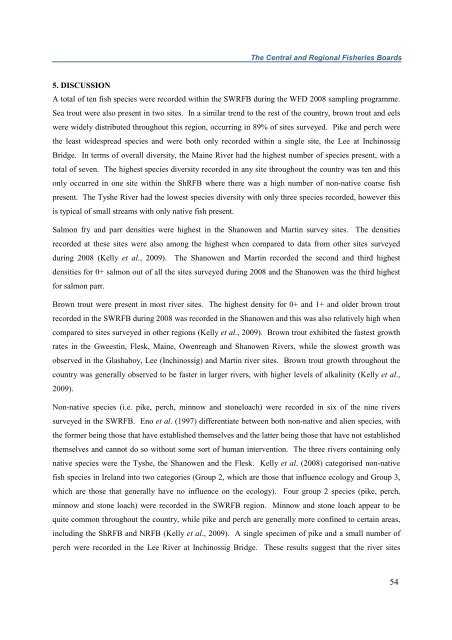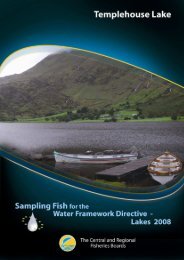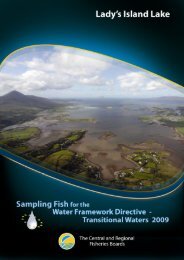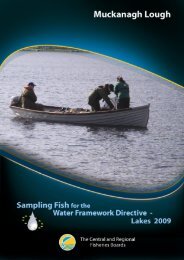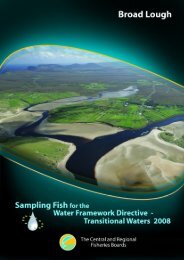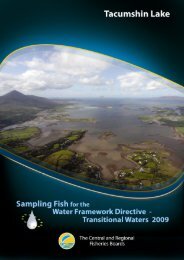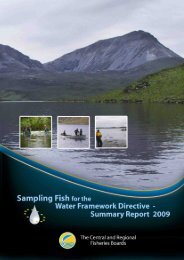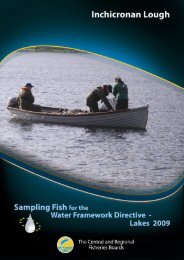HERE - Inland Fisheries Ireland
HERE - Inland Fisheries Ireland
HERE - Inland Fisheries Ireland
You also want an ePaper? Increase the reach of your titles
YUMPU automatically turns print PDFs into web optimized ePapers that Google loves.
The Central and Regional <strong>Fisheries</strong> Boards5. DISCUSSIONA total of ten fish species were recorded within the SWRFB during the WFD 2008 sampling programme.Sea trout were also present in two sites. In a similar trend to the rest of the country, brown trout and eelswere widely distributed throughout this region, occurring in 89% of sites surveyed. Pike and perch werethe least widespread species and were both only recorded within a single site, the Lee at InchinossigBridge. In terms of overall diversity, the Maine River had the highest number of species present, with atotal of seven. The highest species diversity recorded in any site throughout the country was ten and thisonly occurred in one site within the ShRFB where there was a high number of non-native coarse fishpresent. The Tyshe River had the lowest species diversity with only three species recorded, however thisis typical of small streams with only native fish present.Salmon fry and parr densities were highest in the Shanowen and Martin survey sites. The densitiesrecorded at these sites were also among the highest when compared to data from other sites surveyedduring 2008 (Kelly et al., 2009). The Shanowen and Martin recorded the second and third highestdensities for 0+ salmon out of all the sites surveyed during 2008 and the Shanowen was the third highestfor salmon parr.Brown trout were present in most river sites. The highest density for 0+ and 1+ and older brown troutrecorded in the SWRFB during 2008 was recorded in the Shanowen and this was also relatively high whencompared to sites surveyed in other regions (Kelly et al., 2009). Brown trout exhibited the fastest growthrates in the Gweestin, Flesk, Maine, Owenreagh and Shanowen Rivers, while the slowest growth wasobserved in the Glashaboy, Lee (Inchinossig) and Martin river sites. Brown trout growth throughout thecountry was generally observed to be faster in larger rivers, with higher levels of alkalinity (Kelly et al.,2009).Non-native species (i.e. pike, perch, minnow and stoneloach) were recorded in six of the nine riverssurveyed in the SWRFB. Eno et al. (1997) differentiate between both non-native and alien species, withthe former being those that have established themselves and the latter being those that have not establishedthemselves and cannot do so without some sort of human intervention. The three rivers containing onlynative species were the Tyshe, the Shanowen and the Flesk. Kelly et al. (2008) categorised non-nativefish species in <strong>Ireland</strong> into two categories (Group 2, which are those that influence ecology and Group 3,which are those that generally have no influence on the ecology). Four group 2 species (pike, perch,minnow and stone loach) were recorded in the SWRFB region. Minnow and stone loach appear to bequite common throughout the country, while pike and perch are generally more confined to certain areas,including the ShRFB and NRFB (Kelly et al., 2009). A single specimen of pike and a small number ofperch were recorded in the Lee River at Inchinossig Bridge. These results suggest that the river sites54


